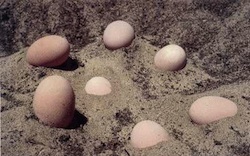Some interesting Malleefowl facts:
The Bird
Mound building birds belong to the family known as the Megapodiidae or ‘megapodes’. The name mega-pod refers to the exceptionally large feet.
Incubator Mound (Nest)
1) The incubator mound comprises a large mass of sand, usually 3-5 metres in diameter and up to one metre high, within which up to a cubic metre of moist leaf litter is buried.
2) Early in the breeding season the heat for the incubation of the eggs is produced by the decomposition of the leaf litter. The main function of the leaf litter incorporated into the mound is to enable the birds an early start to egg laying.
3) Late in the season, heat from the sun is also utilised.
Eggs
1) Egg laying usually begins in September and an egg is laid every 5-7 days until mid to late summer.
2) The incubation period of eggs varies with temperature, but is about 60 days at typical nest temperatures.
3) Average clutch size varies between years and localities, but is usually around 15-25 eggs.
Chicks
1) Chicks typically begin hatching and emerging from mounds in November, and although hatching may continue until March in some seasons, most chicks usually emerge from mounds before January .
2) Chicks hatch, buried with up to a metre of sand above them, and their unaided struggle to the surface may take up to 15 hours.
3) The chicks receive no parental care after hatching, but like other megapodes can thermoregulate efficiently, run and feed themselves almost immediately and fly within 24 hours.
4) Mortality of chicks is very high over the first few weeks after hatching. Studies have recorded mortality at about 80% over the first ten days or so.